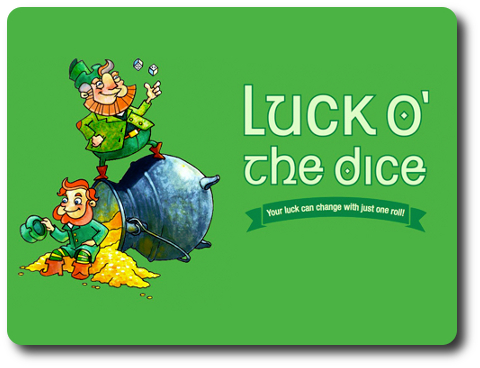
The Basics:
- For ages 7 and up
- For 2 to 4 players
- Approximately 20 minutes to complete
Geek Skills:
- Counting & Math
- Logical & Critical Decision Making
- Reading
- Pattern Matching
- Risk vs. Reward
- Hand/Resource Management
Learning Curve:
- Child – Easy
- Adult – Easy
Theme & Narrative:
- Dice and cards combine to create a game of luck and fortune
Endorsements:
- Gamer Geek rejected!
- Parent Geek approved!
- Child Geek approved!
Overview
American playwright, critic and writer of film scenarios Channing Pollock said, “The only good luck many great men ever had was being born with the ability and determination to overcome bad luck.” In this game, the roll of the dice might be random, but players always have a choice. A quick scan of the table will show the player how far behind they are and how hard they need to push their luck to change the game’s outcome.
Luck O’ the Dice, designed by Jacob Zurcher, Heather Zurcher, Mark Greenburge, and published by Zark LLC, is comprised of 24 standard six-sided dice, 25 silver coins, 40 gold coins, 4 Reference cards, 45 Dice cards, and 23 Leprechaun cards. The cards are as thick and as durable as your standard playing card. The coins are made of plastic. What little artwork there is, by Adam Borgia, can be found on the Leprechaun cards, portraying the impish Irish fairy-folk who like to cause so much trouble.
Searching for the Rainbow
To set up the game, give each player 6 dice. Set any remaining dice back in the game box.
Second, place the coins in the middle of the playing area to form the coin pools. I suggest you put each coin type in a different cup or bowl to make things easier.
Third, give each player a Reference card, placing any not used back in the game box.
Fourth, combine the Dice and Leprechaun cards to form one deck and shuffle. Deal 5 cards to each player, face-down. Place the rest of the deck face-down off to one side of the game playing area and within easy reach of all the players. Leave room for a discard pile. Players should look at their cards, but keep them hidden from their opponents.
That’s it for game set up. Determine who will go first and begin.
The Lure of Gold
Luck O’ the Dice is played in turns with no set number of turns per game. A player’s turn is comprised of 3 steps.
Step 1: Leprechaun Play
At the start of the player’s turn, they may optionally play 1 Leprechaun card from their hand. If a card is played, it’s placed in front of the player and read out loud. The card is then resolved, following the card’s instructions. Once the card is resolved, it’s discarded face-up and the player’s turn continues.
Leprechaun cards force opponents to share dice, allow the player to steal coins, remove coins from the lead player, skip an opponent’s turn, reduce the number of dice an opponent can use for 1 turn, steal a card from an opponent’s hand, and even stall the end of the game. In short, these cards mess with the game rules and the player’s opponents.
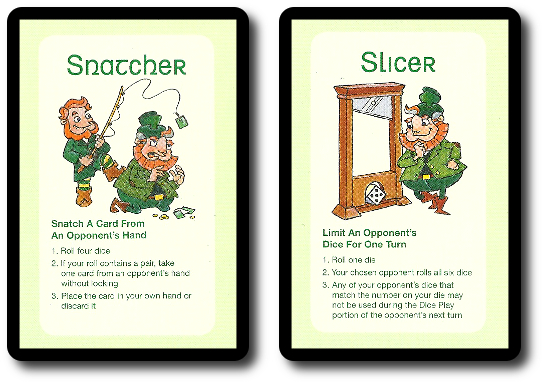
Opponents can play 1 Dice card from their hand that has shamrocks in the card’s corners to avoid the effects of the Leprechaun card. If the Leprechaun card effects everyone in the game, the opponents who play the Dice cards with shamrocks avoid the Leprechaun card’s effects, while everyone else must resolve the card. But this perk comes at a price. The played Dice card is lost to the discard pile.
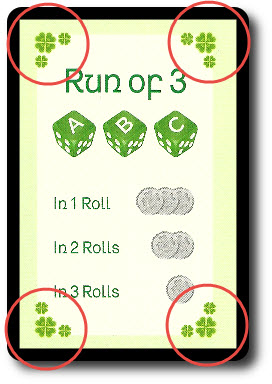
Step 2: Dice Play
After the player has played a Leprechaun card or not, they take their dice and roll them. Dice can be rolled up to 2 times on the player’s turn with the goal to complete 1 of 3 different objectives. Dice the player wants to keep can be set aside. Players need not announce what they are attempting to achieve during this step in the game.
Complete Dice Card
Each Dice card shows a combination of dice in either a run or a set. Any Dice card in the player’s hand can be used and need not be announced prior to the player rolling the dice. If the values rolled match any of the player’s Dice cards, they can reveal the matching Dice card and collect the number of coins listed. If the player matches the Dice card on their first roll, they collect the number of coins listed for “In 1 Roll”. If the player matches the Dice card on their second roll, they collect the number of coins listed for the “In 2 Rolls”. If the player matches the Dice card on their third roll, they collect the number of coins listed for the “In 3 Rolls”.
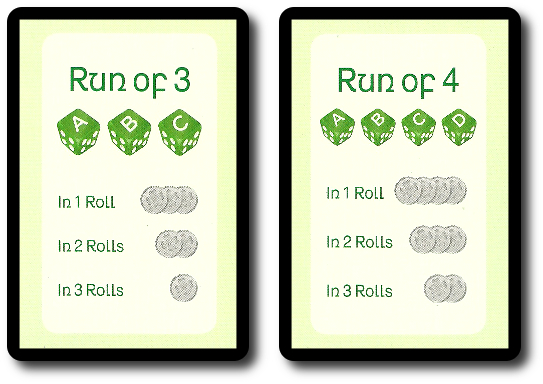
The collected coins are placed in front of the player. Earned coins should always be visible to opponents, as well. Silver coins have the value of “1” and the gold coins have the value of “5”. Players should feel free to make change if needed.
If the Dice card is completed, it’s kept by the player in a pile, face-up. The pile should be organized so as to allow opponents to easily count the number of Dice cards in it.
Gain More Cards
Within 2 rolls, the player can attempt to obtain more cards. This is done by rolling a 3 of a Kind (2, 2, and 2, for example). If they succeed, they draw 3 cards from the draw pile, keep up to 2, and discard the rest. While cards will give the player more options, they also penalize the player at the end of the game. This objective cannot be attempted during step 3.
Pot O’ Gold Combos
The Pot O’ Gold combos are listed on the Reference card. If the player is able to match any of the listed combos on their first or second roll attempt, they can announce the Pot O’ Gold comb they completed and collect the appropriate amount of coins. This objective cannot be attempted during step 3.
Step 3: Press Your Luck
After attempting to complete 1 of the 3 possible objectives, and failing to do so within 2 rolls, the player can press their luck by rolling a third time. This step is optional and is skipped if the player completed an objective during step 2.
If the player wants to push their luck, they announce which Dice card they are attempting to roll for, placing it in front of them. Then they roll the dice.
- If the roll is successful, the player is awarded the amount of coins listed for “In 3 Rolls”. The Dice card is then placed in a pile with the other completed Dice cards.
- If the roll fails, the player rolls 1 die and places 2 silver coins back to the pool if they roll an even number. If the number rolled is odd, the player looses nothing. Either way, the Dice card remains in the player’s hand.
The player’s turn is now over. The next player in turn order sequence now takes their turn starting with step 1 noted above.
At the End of the Rainbow
The game ends as soon as a player completes a total of 5 Dice cards on their turn. Points are now calculated by first resolving a bonus and then 3 penalties.
“First Out Bonus”
The first player to complete 5 Dice cards and end the game now gets to roll 1 die. The rolled value earns the player that many silver coins, which is now added to any coins they have already earned.
“Subtractor Penalty”
Now all players look through the cards still in their hand and reveal any “Subtractor” Leprechaun cards they have not yet played. For each card revealed, the player loses 5 silver coins.
“Dice Card Penalty”
Then the player reveal any Dice cards still in their hand. If they have any, they lose 2 silver coins per Dice card.
“Leprechaun Card Penalty”
Finally, the players reveal any remaining Leprechaun cards still in their hand. If they have any, they lose 1 silver coin per Leprechaun card. The “Subtractor” Leprechaun card has already been penalized and does not count.
All players now count up their coins. Again, silver coins are worth “1” and gold coins are worth “5”. The player with the highest value in coins wins the game.
To learn more about the game, visit the game’s web page or Facebook profile.
Final Word
The Child Geeks listened carefully to the rules and only had a few questions about the game. Most of the questions revolved around the Leprechaun cards and their proper use. For the most part, the Child Geeks had no real issues other than their growing frustration at the dice. According to one Child Geek, “The only thing about this game I don’t like is the stupid dice. I think my dice or broken…or stupid. I bet they are both.” As frustrating as random results can be, all the Child Geeks recognized that they had a lot of choices in the game. Each roll of the dice presented a new opportunity to play a Dice card, go for the Pot O’ Gold, or attempt to get new cards. The only time the Child Geeks felt they had failed during their turn was when nothing came of it. As one Child Geek put it, “You should be able to do something each turn. Even if you don’t earn any coins, getting more cards early in the game is really going to help you.” Very wise. When all the dice were rolled and the coins counted, the Child Geeks voted to approve Luck O’ the Dice.
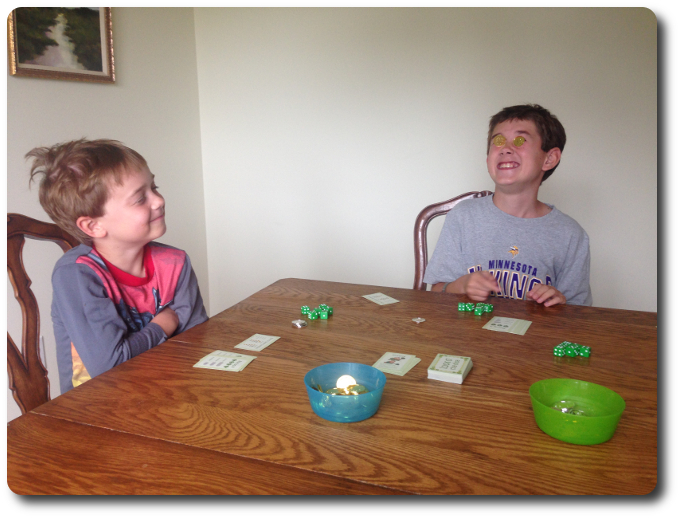
An older brother brags that he is “so money” that even his eyes are gold coins. He lost the game.
The Parent Geeks found the game to be casual and fun with just the right amount of player engagement to make it an entertaining game. They were not happy that the game only allowed 4-players, however. According to one Parent Geek, “I don’t know why this game only allows 4 players. You can certainly have more and I don’t think it would do anything other than make the game a bit longer. But then, at least, everyone could play.” A large number of the Parent Geeks thought Luck O’ the Dice was a better form of Yahtzee. As one Parent Geek put it, “All the fun dice rolling and critical thinking is here, but what puts this game above the rest is the cards. I love that I have so many choices and that timing is so meaningful. The game is a lot of fun.” All the Parent Geeks found Luck O’ the Dice to be a fun and entertaining game with their families and with their peers, with the only big disappointment being the total number of players.
None of the Gamer Geeks enjoyed the game. According to one Gamer Geek, “All you are doing is rolling dice and collecting them when you think it’ll make the most money. You do that the entire game. The only thing that saves you from falling asleep is the Leprechaun cards that inject a very welcoming surge of life in a game that feels terribly unoriginal.” Rather harsh criticism and one that was not shared by other Gamer Geeks. At the very least, the majority of Gamer Geeks felt that Luck O’ the Dice was worth a single play and was best left to families. At the most, a few of the Gamer Geeks believed the game would be good fun for a casual game filler. According to one of these Gamer Geeks, “Yes, this game is heavily based on luck, but the players get to make their own luck using the cards. So it’s not fully luck based. And the Leprechaun cards add in some interesting twists. In the end, you must have played your cards as well as you played the odds. I rather like that and would be happy to play this game anytime.” More than just a few Gamer Geeks felt the same, but not enough to win over the majority or to tip the scales even. The end result was the Gamer Geeks rejecting Luck O’ the Dice.
Luck O’ the Dice is very casual, but players will need to do some critical thinking if they hope to compete. The different objectives always provide the player options, which can actually cause the player to think harder than they normally would. The problem is one of choice. Does the player use the Dice card now and earn 2 coins or do they wait and hope to get the 4 coins? Players must also consider the fact that each Dice card they take moves the game to the end, even if they don’t want it to end. The choices in this game are meaningful – very meaningful – but that fact often gets lost in the noise of the dice being rolled. Some parties only focused on the dice and what they saw was a game full of random outcomes and lucky rolls. For those who looked at the cards and the hand management necessary to collect as many coins as possible, the game had nothing to do with luck.
Both parties are right, in this case. Luck O’ the Dice is a game full of random outcomes and opportunities. Choice is based on the previous outcome and so it goes, over and over again, with each player risking just enough to move 2 steps ahead of their opponents. Of course, risk by its very nature suggests the possibility of failure and players will experience that, too. Pushing your luck is not a bad thing, but towards the end of the game, players will be risking it all in a last-ditch effort to get rid of cards and make just a few more coins. As the game reaches its end, so too does the level of tension and frustration rise.
I enjoyed the game, found it to contain a good mix of luck, critical thinking, and hand management. I continue to hate dice, but only because they hate me. Casual players and those who enjoy games were risk and reward are at the heart of things will enjoy Luck O’ the Dice. Players looking for a game with depth, strategy, and tactics should look elsewhere. This game is all about rolling dice, crossing your fingers, and suffering from painful hindsight. Give it a go if Luck O’ the Dice sounds like your kind of game.
This game was given to Father Geek as a review copy. Father Geek was not paid, bribed, wined, dined, or threatened in vain hopes of influencing this review. Such is the statuesque and legendary integrity of Father Geek.



